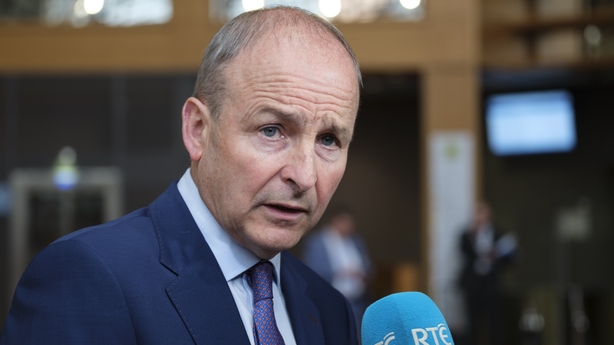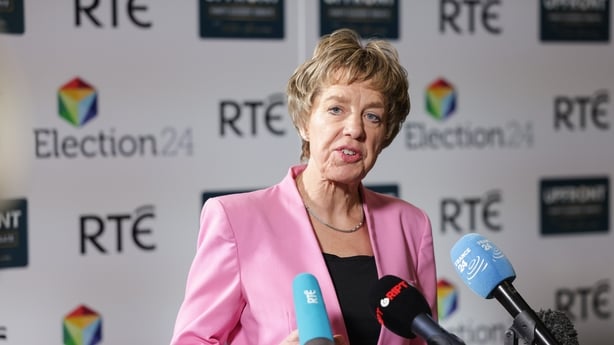Parties and candidates have spent more than €330,000 on ads on social media platforms so far during the general election campaign, according to data published yesterday.
The vast majority of this was spent with Meta, which operates Facebook and Instagram, with the rest being spent on Google sites, like YouTube.
During previous recent campaigns, Sinn Féin has been - or has tracked close to – the highest spending Irish party on digital advertising. However, so far in Election 2024 it has been heavily outspent not just by Fine Gael and Fianna Fáil but also Labour.
The Social Democrats has even slightly outspent Sinn Féin.
Sinn Féin has spent €23,343 on Facebook and Instagram advertising, compared to Fine Gael's €85,576 and Fianna Fáil’s €72,273. The available Meta data covers spending until Friday 22 November.
Sinn Féin has spent nothing on Google, compared with €17,000 and €5,000 from Fine Gael and Fianna Fáil respectively.
We need your consent to load this flourish contentWe use flourish to manage extra content that can set cookies on your device and collect data about your activity. Please review their details and accept them to load the content.Manage Preferences
During the local and European election in June, Sinn Féin outspent all other parties for weeks, until the final days of the campaign when it was surpassed by a surge of spending by Fine Gael.
It is understood Sinn Féin is holding its spending resources for a major ramp-up in digital advertising in the final days of the election.
Sinn Féin had been spending around €1,200 a day on Meta ads. On Wednesday last, this increased to €1,600, then €1,900 on Thursday, followed by €4,000 Friday, the most recent day for which there is data available.
Typical daily spends
The overall spending data, collated by transparency group, Who Targets Me, also shows there was a significant spike in daily spending by Fine Gael in the days prior to the formal declaration of the election date of 29 November.
On 6 November, Simon Harris appeared on the RTÉ’s Six One News and said he "hoped" the election would be held on 29 November.
His appearance followed comments from Green Party leader Roderic O’Gorman and Fianna Fáil’s Micheál Martin, in which they said they also expected polling to be on that date.
In the days before his Six One appearance, Fine Gael spending on digital ads spiked from between €2,000 and €4,000 per day, to €13,527 on 4 November and €11,097 on 5 November.
We need your consent to load this flourish contentWe use flourish to manage extra content that can set cookies on your device and collect data about your activity. Please review their details and accept them to load the content.Manage Preferences
This spending went on multiple video ads in which party leader Simon Harris was placed to the fore, standing alongside local constituency candidates.
Each advert had similar accompanying text, saying the candidate "has been working hard for you and your family."
That wave of ads mainly ran until 8 November, after which Fine Gael’s spending plateaued. It has remained between €4,000 and €7,000 on each day of the campaign since.
By comparison, Fianna Fáil spending spiked on 8 November, the first formal day of the campaign, at €15,900. It has since settled to between €2,000 and €4,000 daily.
What are the messages within the ads and who is seeing them?
Over recent elections, parties and candidates have been focusing increasingly on reaching voters on social media platforms, and have made their ads on certain platforms a prominent feature of their campaign.
Large platforms are required to publish political ad spending data under the European Digital Services Act. Meta and Google both maintain transparency data libraries from which detailed information is typically available.
X - formerly Twitter - is also subject to the Digital Services Act, however researchers point to difficulties accessing data on ads published by the company.
Other platforms, like TikTok, say they do not allow political ads. On TikTok, the prominence of the content published by the parties is 'organic,’ in other words not boosted by advertising cash.
Parties' advertising strategies
Ads running on the parties’ official pages on Facebook and Instagram show potential voters are primarily being targeted based on their location.
Generally, the messaging seen in the social media ads are in line with the wider communications strategies of each campaign.
At the beginning of the campaign, Fine Gael’s focus was centred on the "new energy" of Mr Harris.

Days before the campaign kicked off, on 4 November, Fine Gael launched dozens of ads featuring the party leader standing with a local candidate. These ads were each geographically targeted to areas within that candidate’s constituency.
Other ads launched later in the campaign featured Mr Harris with a group of children talking about childcare, or with outgoing government ministers talking about their record in office.
During the second week of the campaign, Fine Gael paid between €900-999 for an attack ad that ran from 20-23 of November on Meta, questioning whether Sinn Féin could be trusted with the public finances. On Meta, it reached around 107,000 users.
Fianna Fáil began their campaign by running a wave of micro-targeted ads aimed at users in different areas of the country aged 22 and above. 380 different versions of the same core ad - each version locally targeted - were published.
They were all based on a high production value video of Mr Martin talking about the party's record. Roughly €100 was spent on each localised version, which all ran from 8 November to 11 November.

During the initial days of the campaign, Fianna Fáil also promoted a clip of Mr Martin meeting comedic impressionist Mario Rosenstock while out canvassing. In it, Mr Rosentock compliments the party leader on his Muhammad Ali impression, which is then shown in the video, along with the caption 'GOAT' and an emoji of a boxing glove.
The party spent about €1,800 promoting the clip on Meta, reaching more than 290,000 users nationwide.
Almost all other ads within Fine Gael and Fianna Fáil’s early waves were heavily localised, with small areas around the country - down to named specifics like 'Rochfortbridge,' 'Cootehill,' and 'Termonfeckin' - overtly mentioned in the targeting data.
None of the ads seem to be targeted narrowly by age or gender, according to the data shared on Meta platforms.
Sinn Féin have taken a different approach, not just in spending but in strategy.
Ads run by Sinn Féin’s central account across the campaign have tended to feature the party leader, Mary Lou McDonald, and have far fewer versions than those run by the other two major parties.

Sinn Féin appears to be trying to maximise impact by specifying gender, app preference, and age ranges, rather than geographic location.
On the first day of the campaign, several versions of the party’s launch advert were published. Some targeted a 45-to-65 age demographic, others 18-to-45. Each was specifically targeted to men or women, and also to Facebook or Instagram, not both.
Locations were listed simply as "Ireland".
In recent days the party has been running an ad featuring Mary Lou McDonald talking directly to camera from behind a podium. She describes the election as an opportunity of a lifetime, saying "the only way to get a change of government is to vote Sinn Féin on Friday 29 November."
Similarly, four versions of that ad have been run, all targeting users aged 18 to 44, with versions split only by gender and preferred app (i.e. a version for Instagram and another for Facebook).
While Fine Gael and Fianna Fáil have tended to put around €100 behind each localised version of an advert, Sinn Féin is backing fewer versions with more money. Each version of the currently-active ad is backed by about €800 in spending.
Nevertheless, the €23,343 Sinn Féin spent to Friday has been overshadowed by the third-highest spender of the campaign so far, Labour, which has splashed about €55,000 with Meta since 8 November.
Two types of ads are being placed by Labour. One type features the leader, Ivana Bacik, often as part of a media appearance, speaking about broad issues like Palestine or housing.
The other type is fronted by Labour candidates, who speak on constituency issues.

The text accompanying those adverts is also localised, with examples including "as a former student in St Joseph's, I will keep the pressure on this project," "we need to get public transport working in Cork," and "Mental health services in Wexford are in crisis. I want to ensure this changes."
The candidate-led ads tend to be geographically targeted to issues in specific constituency areas: transport-focused ads are targeting commuter towns or areas along rail lines, for example.
The Social Democrats have spent roughly €25,000 on Meta ads so far. 13 adverts are currently live on the party’s main account, meaning they are being shown to Meta users.
Of these, ten are fronted by party leader, Holly Cairns. These ads are primarily targeted at the county level, rather than being further localised.
Multiple other ads are running through pages operated by individual Social Democrats candidates. These adverts tend to be constituency-specific, but centred on housing or health issues.
Reactive advertising
Of the three larger parties, only Fianna Fáil appears to have run ads reacting to issues arising along the campaign.
On the morning after the viral clip of Mr Harris walking away from a woman working in the care sector in Cork began circulating, Fianna Fáil published two new ads on Meta.
Each ad showed their Dublin North-West candidate Paul McAuliffe, the party spokesperson on social protection, talking about Fianna Fáil’s support for care workers. They had the caption ‘Fianna Fáil values carers’.
The party ran 34 versions of that ad, each aimed at different locations around the country.
Google Ads
Beyond Meta, Google also publishes spending data on ads placed on its video publishing site, YouTube, and within Google products, like Google Search.
Some €28,000 has been spent by parties and candidates in total over the campaign, with Fine Gael by far the biggest spender on Google also. It paid €17,000 to show 11 ads, most of which were placed on YouTube.
Fianna Fáil did not start their campaign on Google until 14 November. It has spent almost €5,000 on eight video ads.
Notably, Sinn Féin has not yet spent anything with Google, again marking a difference with its approach to the local and European elections.
It spent €10,000 with Google in the comparable period ahead of polling day during that campaign, much more than other parties at the time.
Final days loom large
As the campaign enters its final days, it is likely the amount of money parties will spend will ramp up further.
Data from the Electoral Commission shows the majority of voters, particularly young voters, decide who they will select in the days leading up to polling day.
Previous elections have shown that parties majorly accelerate their spending in the final week of the campaign.
During the local and European elections, parties spent up to 11 times more than what they spent three weeks out from polling day.







